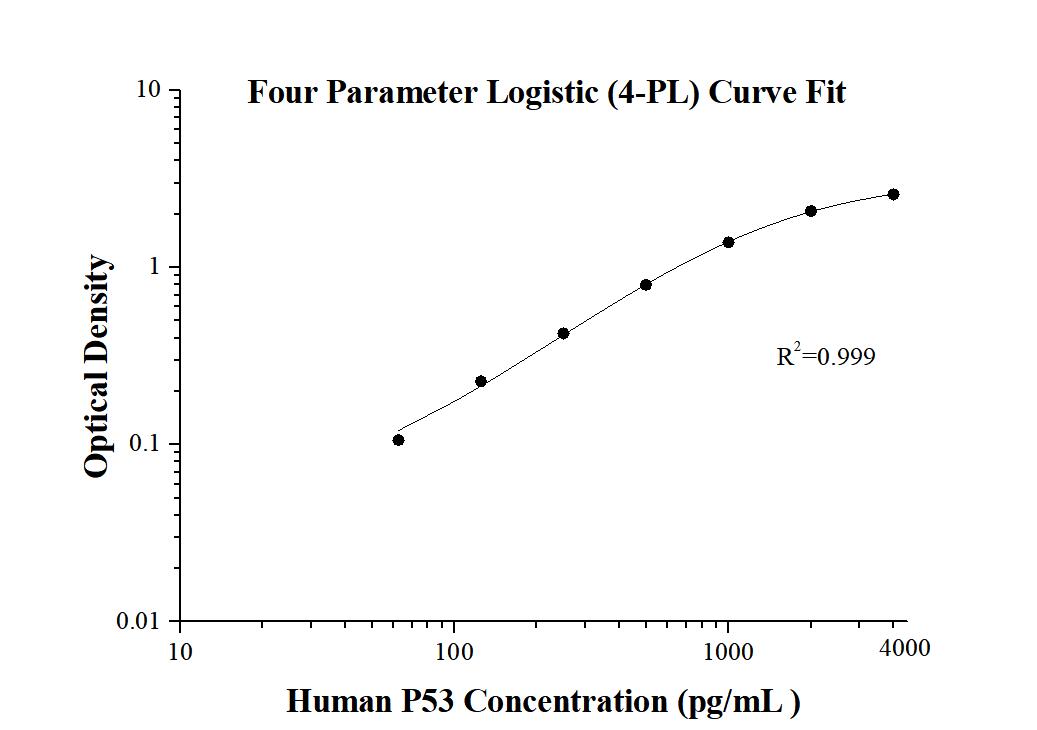Human P53 ELISA Kit
Sensitivity
51.64 pg/mL
Range
62.5-4000 pg/mL
Reactivity
Human
Cat no : KE00244
Synonyms
Antigen NY CO 13, Cellular tumor antigen p53, FLJ92943, LFS1, P53, Phosphoprotein p53, TP53, TRP53, tumor protein p53, Tumor suppressor p53
Validation Data Gallery
Product Information
KE00244 is a solid phase sandwich Enzyme Linked-Immuno-Sorbent Assay (Sandwich ELISA). The P53 ELISA kit is to be used to detect and quantify protein levels of endogenous P53. The assay recognizes human P53. An antibody specific for P53 has been pre-coated onto the microwells. The P53 protein in samples is captured by the coated antibody after incubation. Following extensive washing, another antibody specific for P53 is added to detect the captured P53 protein. For signal development, horseradish peroxidase (HRP)-conjugated antibody is added, followed by Tetramethyl-benzidine (TMB) reagent. Solution containing sulfuric acid is used to stop color development and the color intensity which is proportional to the quantity of bound protein is measurable at 450 nm with the correction wavelength set at 630 nm.
| Product name | Human P53 ELISA Kit |
| Tests | 1 X 96 well plate |
| Sample type | Cell lysate |
| Assay type | Sandwich |
| Sensitivity | 51.64 pg/mL |
| Range | 62.5-4000 pg/mL |
| Reactivity | Human |
| Tested applications | Sandwich ELISA |
| Gene ID (NCBI) | 7157 |
Recovery
| Sample Type | Average | Range |
|---|---|---|
| Cell lysate | 95% | 78%-115% |
IntraAssay
| Sample | n | mean ( pg/mL) | SD | CV% |
|---|---|---|---|---|
| 1 | 20 | 1,903.2 | 40.8 | 2.1 |
| 2 | 20 | 431.8 | 14.0 | 3.2 |
| 3 | 20 | 95.0 | 5.7 | 6.0 |
InterAssay
| Sample | n | mean ( pg/mL) | SD | CV% |
|---|---|---|---|---|
| 1 | 24 | 1,813.6 | 80.1 | 4.4 |
| 2 | 24 | 410.2 | 21.3 | 5.2 |
| 3 | 24 | 90.4 | 8.9 | 9.9 |
Background Information
P53, also known as TP53, belongs to the p53 family, in SDS-PAGE, the observed molecular weight is about 53 kDa. P53 acts as a tumor suppressor in many tumor types, including growth arrest or apoptosis depending on the physiological circumstances and cell types. P53 is activated in response to alteration of normal cell homeostasis, including DNA damage, nutrient starvation, heat shock, virus infection, pH change, hypoxia, and oncogene activation. P53 maintains genetic stability by regulating different processes, such as cell-cycle arrest, DNA synthesis and repair, programmed cell death, and energy metabolism. Activation of p53 can lead to either cell cycle arrest and DNA repair or apoptosis . P53 can be phosphorylated by ATM, ATR, and DNA-PK at Ser15 and Ser37.
Properties
| Storage Instructions | All the reagents are stored at 2-8℃ for 6 months or -20℃ for 12 months. Refer to the protocol for further storage instructions. |
| Synonyms | Antigen NY CO 13, Cellular tumor antigen p53, FLJ92943, LFS1, P53, Phosphoprotein p53, TP53, TRP53, tumor protein p53, Tumor suppressor p53 |
